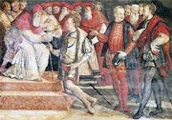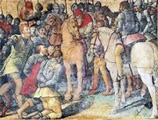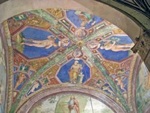Tommaso Bernabei was born in Cortona. He is sometimes said to have studied under Luca Signorelli, but there is no direct evidence of this (see the reference below). Giorgio Vasari’s claim that he was a disciple of Giulio Romano in Rome in ca. 1520 is more widely accepted. Vasari also records that he worked under Giovanni Battista Caporali for Cardinal Silvio Passerini on the frescoes of the Palazzone, Cortona in 1521‑29, the years in which Passerini acted as papal legate to Perugia and the Duchy of Spoleto.
The only known signed work by il Papacello (and Vittore Cirelli) is an altarpiece (1532) of the Annunciation with SS Fidelis and Lazarus, which came from San Fidele, Montone and is now in the Pinacoteca there.
Cesi
Madonna and Child (ca. 1538)
This fresco, which was originally part of a larger composition, was detached from the left wall of Santa Maria Assunta in 1922 and moved to its current location, in a room off the sacristy. It is probably the fresco by il Papacello that was documented in 1540, when Giovanni Battista Caporali and il Papacello were contracted to “correct” such a work, for which payment was still outstanding.
Città di Castello
Adoration of the Shepherds (16th century)
This altarpiece in the Pinacoteca came from an altar in San Domenico that belonged to the Marchesani family. It is stylistically close to the altarpiece in Montone mentioned above. It has been attributed to Vittore Cirelli; however, Mario Gori Sassoli (referenced below) attributed it to il Papacello.
Perugia
Frescoes in Rocca Paolina (1543-4)
Giorgio Vasari reports that Lattanzio Pagani began the decoration of the newly built Rocca Paolina. Cristofano Gherardi, il Doceno (who was a close associate of Vasari) “not only assisted ... Lattanzio, but afterwards executed with his own hand the greater part of the best works that are painted in the apartments of that fortress, in which there also worked Raffaellino del Colle and Adone [Dono] Doni of Assisi, an able and well-practised painter .... Tommaso [Bernabei, il] Papacello also worked there ...”
This is the only surviving record of the commissioning of the frescoes of Rocca Paolina. Paul III had built the fortress after his subjugation of the rebellious Perugians in 1540, so it is unsurprising that the team included no Perugian artists: indeed, apart from Dono Doni, all the artists came from outside Umbria. They were to spearhead the introduction of Mannerist art to the city of Perugino. Unfortunately, all of their work here was lost when the fortress was demolished in 1860.
Vasari is explicit the work had been commissioned by “Messer Tiberio Crispo, who was governor and castellan at that time”. A number of considerations suggest that the time in question was 1543-4:
-
✴Serafino Siepi, who described the surviving and frescoes in his guide of 1822, says that those in the chapel (which he attributed to Dono Doni) were dated by inscription to 1543;
-
✴Giorgo Vasari says that he called Cristofano Gherardi from Perugia to Rome in 1543, where he stayed for “many months”;
-
✴Raffaellino del Colle is documented in Perugia in June 1544;
-
✴Tiberio Crispo became a cardinal in December 1544, after which the title “Messer” would have been inappropriate; and
-
✴Giorgio Vasari called Cristofano Gherardi and Raffaellino del Colle (whom he describes as his “friends and pupils”) to Naples in 1545, albeit that Cristofano was too ill to respond.
Scenes from the Life of Braccio Fortebracci (1547-8)


Cardinal Tiberio Crispo commissioned these frescoes in the frieze around the Sala della Congregazione Governativa of Palazzo dei Priori (now Room 18 of the Galleria Nazionale). They are attributed to Tommaso Bernabei, il Papacello (and sometimes also to Lattanzio Pagani).
The frescoes depict:
-
✴Pope John XXIII conferring the fiefdom of Montone, the governorship of Bologna and the baton of command of papal forces on Braccio in 1410 (a detail of which is illustrated above, on the left);
-
✴Braccio’s victory at the Battle Sant' Egidio in 1416, after which he became Lord of Perugia (a detail of which is illustrated above, on the right);
-
✴the investiture of Braccio as Prince of Capua in 1424; and
-
✴the Battle of l’ Aquila (1424), in which Braccio was defeated by papal forces, and after which he died as a prisoner of war.
In the two scene illustrated above, the figure of Braccio is actually a portrait of Pope Paul III, who had taken Perugia in 1540. Thus, although these scenes ostensibly celebrate Braccio’s achievements, they also depict his ultimate defeat and the more recent defeat of Perugia at the hands of the papacy.
Panels (1547-8)
Six panels that had been removed from the ceiling of the Udienza dei Delegati in Palazzo Priori (now Room 10 of the Galleria Nazionale) in 1798 were documented in 1822 with an attribution to il Papacello. They depicted:
-
✴four reclining warriors; and
-
✴two scenes depicting the aggression of Jove:
-
•the rape of Europa; and
-
•the rape of Ganymede.
The rape of Europa has been lost, but the others survive (albeit in poor condition) in the Deposit of the Galleria Nazionale.
The allusion to Jove was undoubtedly a reference to the conquering Paul III: similar scenes were depicted temporarily in the frescoes painted on a city gate by Cristofano Gherardi, il Doceno for the entrance of Paul III into the defeated city in September 1541.
Trinity with the Virgin and Saints (1553)
In 1553, Lattanzio Pagani signed an undertaking with Sforza di Lionello degli Oddi, according to which he agreed to ensure that his father, Vincenzo Pagani and il Papacello would paint this altarpiece for the Cappella degli Oddi in San Francesco al Prato. The undertaking specified the presence of SS Francis, Antony of Padua, John the Baptist and Bernardino of Siena, although only the first three of these appeared in the delivered work. It was transferred to the Galleria Nazionale in 1863. Although its poor condition makes attribution difficult, it is generally thought to be largely the work of il Papacello.
Spoleto
Frescoes (ca. 1535)

-
✴Giovanni da Spoleto, who is known only from his signature (along with that of Vincenzo Tamagni) on the frescoes (1516) in the apse of Santa Maria di Arrone (see the page on the chapel in the Duomo); or
-
✴il Papacello (by Mario Gori Sassoli, referenced below).









